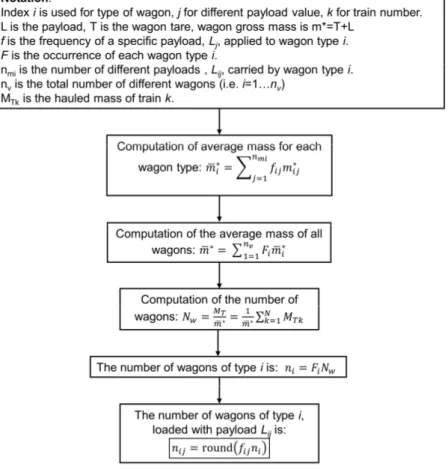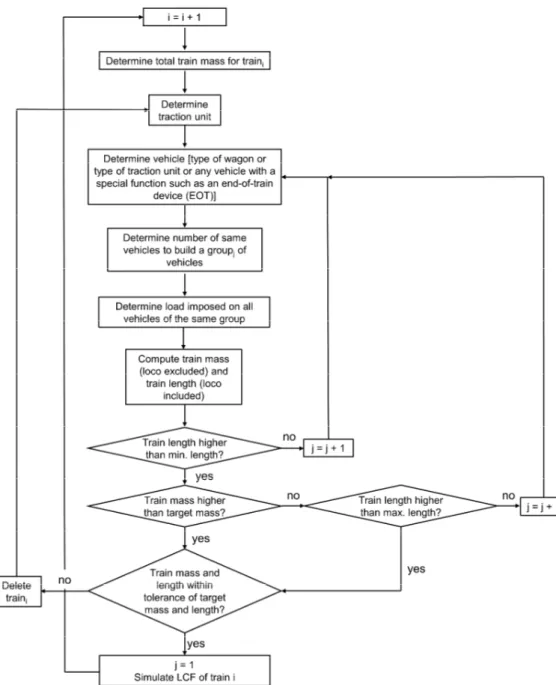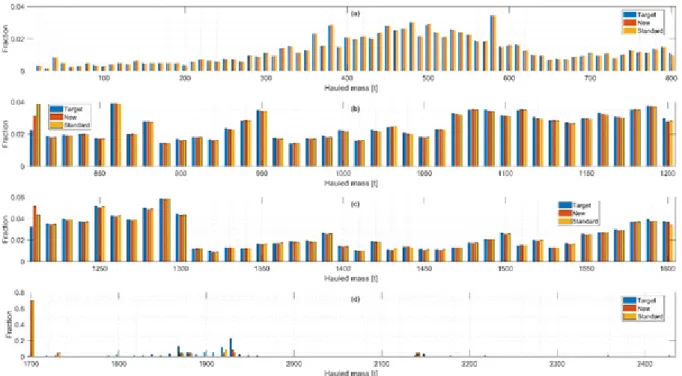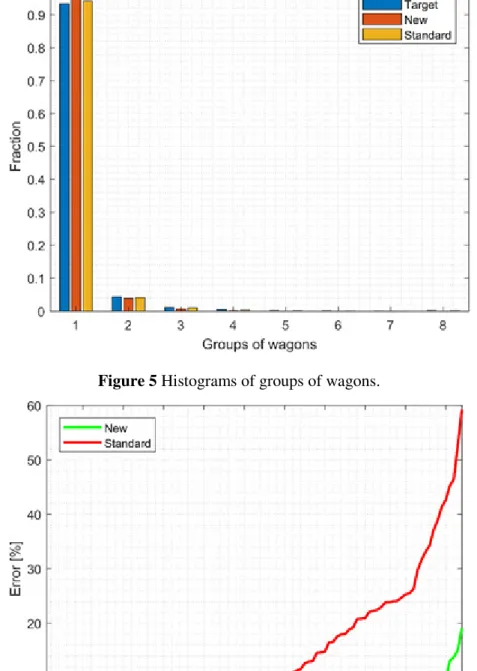Available online at http://www.iaeme.com/ijmet/issues.asp?JType=IJMET&VType=9&IType=10 ISSN Print: 0976-6340 and ISSN Online: 0976-6359
© IAEME Publication Scopus Indexed
NEW RANDOM TRAINS GENERATION
ACCORDING TO UIC CODE 421
L. Cantone
Dept. of Enterprise Engineering “Mario Lucertini”
University of Rome “Tor Vergata”, Via del Politecnico 1, Rome, 00133, Italy ABSTRACT
This paper illustrates a new method to generate random trainsets, compliant with UIC CODE 421, which is the common standard followed by Railway Undertakings in Europe for international freight traffic. Random generation of trains is an important topic for risk assessment of new train composition, which is of particular interest in this period in Europe. In fact, there are several studies on new types of trains with distributed traction/braking that require a statistical assessment of Longitudinal Train Dynamics (LTD). Results reported in this paper show that the new method represents more accurately the target payload distribution of real wagons, with respect to the standard method currently proposed by the UIC CODE 421. The new algorithm is suitable for the revision of UIC CODE 421, as a novel way to generate random trains.
Key words: Freight trains, UIC CODE 421, random trains generation, longitudinal train dynamics (LTD), statistical analysis, TrainDy.
Cite this Article: L. Cantone, New Random Trains Generation According to Uic Code 421, International Journal of Mechanical Engineering and Technology, 9(10), 2018, pp. 879–889.
http://www.iaeme.com/IJMET/issues.asp?JType=IJMET&VType=9&IType=10
1. INTRODUCTION
In 2009, UIC established a special group, TrainDy Special Group, to enhance the software
TrainDy, originally developed by the University of Rome “Tor Vergata” with technical and financial support of Faiveley Transport of Italy (a Wabtec company) [1] and [1]. This code is capable to numerically model the time evolution of air pressure in brake pipe and brake cylinders (i.e. the pneumatic problem) as proved in paper [2], based on papers [4]-[5], and the relative motion between consecutive wagons of a trainset (i.e. the dynamic problem). The terminology Longitudinal Train Dynamics (LTD) usually addresses the second type of problem
test campaigns have proved the accuracy of TrainDy pneumatic module in terms of time pressure evolution in brake pipe and brake cylinders, for different braking regimes and multiple discharges of brake pipe. This last feature is typical of trains with distributed traction and braking: [8]-[9] report some further examples of validation results. The pneumatic model has been recently subjected to an improvement in terms of its numerical solver and techniques to obtain its equivalent parameters [10]. For a pneumatic model that directly manages the design parameters of the components of air brake system, such as nozzles diameters, springs stiffness, cams positions and so on, see [11].
TrainDy, as UIC certified software, is currently used in technical departments of DB AG, SNCF and TRENITALIA to address LTD problems. It is well known that wrong decisions concerning the train compositions can cause train derailments [12]-[13], because of high in-train compressive forces or Longitudinal Compressive Forces (LCF). Furthermore, in case of poor LTD assessment, trains can experience a “disruption”, because of failure of draw gears (or draw hooks) caused, in turn, by excessive in-train tension forces or Longitudinal Tension Forces (LTF). Of course, both types of events must be avoided because they can harm people, goods, infrastructure and environment.
In order to prevent such accidents, in Europe, each Country has its own internal limits and prescriptions. At international level, UIC has renewed in 2012 a code (or a “leaflet”), named UIC CODE 421 (or briefly UIC 421) [14]-[15]. This code prescribes a series of limits in terms of train mass and length, depending on train braking regime, to admit freight trains to international traffic. Together with these prescriptions, the leaflet describes a procedure to establish if a new trainset or, better, a family of trainsets with new features (e.g. distributed traction/braking [16]) can cause additional risks to freight traffic of a specific region or service. Using the terminology of UIC 421, this task is accomplished by a “relative approach” which is a common practice in some European Countries. This assessment is performed by comparing the LCFs of virtual trains, statistically generated from probability distributions of real trains. The compared virtual trains represent both existing trains and new trains, performing the same train operation. In Europe, the software used to compute LTD of such trains is TrainDy.
UIC 421 is currently under revision and University of Rome “Tor Vergata” has been involved in this revision process with participation of Experts from SNCF, Trenitalia and DB AG. Among other reasons, this revision is necessary since there are several European projects devoted to increase the capacity and efficiency of freight trains by implementing distributed traction and braking. This is a common practice in many Countries which requires the consideration of new risks, such as the communication loss among traction units. Within the project of revision of UIC 421, there is the improvement of TrainDy braking module to handle composite brake blocks (CBB) type LL and K [17]-[18].
This paper proposes a new algorithm (or method) to generate random freight trains, compliant with standard method of UIC 421; moreover, it expands the current methodology to impose also a limitation in terms of train length. This method is not intended to optimize a specific trainset, as reported in [19] and [20], but rather to represent a current (existing) freight traffic with less computational effort. In fact, sometimes the current traffic involves several tens of thousands of trains and they cannot be modelled on a regular basis, i.e. it is not feasible to compute the LTD for all trains running on a specific region. This is the reason why virtual trains are statistically generated from probability distributions of real trains.
2. RANDOM TRAIN GENERATOR MODEL
The task of generating random trains is crucial for a statistical investigation on in-train forces of a freight train; this topic is, in turn, crucial for a risk assessment of new freight trains, as far as LTD is concerned.
In this section, a numerical algorithm, already described in [15], is summarised for ease of reading. Such algorithm is based on a system of linear equations and it is alternative to the algorithm reported in Appendix B of UIC CODE 421, for the generation of random freight trainsets. This algorithm is described in leaflet UIC 421 by the flowchart reproduced in Figure 1, which is reported as reference. The last box of this flowchart, “Simulate LCF of train”, requires the usage of a software like TrainDy. The new algorithm simply generates train configurations and their computation is accomplished by TrainDy software.
The mass, the traction unit, the wagon type, the number of same wagons to build a group j of wagons, the load of each wagon of the group are defined in terms of probability distributions. Usually, since Railway Undertakings have access to trains running on the railway network, such distributions are expressed in terms of cumulative probabilities, but the new algorithm does not require this feature explicitly.
The UIC 421 algorithm can be also used to determine trains with specified lengths, instead of hauled masses: for this aim, the text of the flowchart should be changed according to Table 1Error! Reference source not found..
Table 1 Rewording of standard flowchart to generate train compositions with specified length
Original sentence New sentence
Determine total train mass of traini Determine total train length of traini
Compute train mass Compute train mass
Train mass higher than target mass? Train length higher than target mass? Train mass within tolerance of target mass? Train length within tolerance of target mass?
Anyway, standard algorithm has been revised for the new version of UIC 421 to handle trains having a specific mass distribution and required to have a train length within a specific interval. This new feature is described later on.
As in the standard algorithm, the input data of new algorithm are: train lengths (LTk); train
masses (MTk) (as in standard algorithm it can manage only one of them at time, but it is possible
to impose boundaries for the other); probability distribution of wagon types expressed in terms of fraction Fi of each wagon model; probability distribution of payload mij carried on by each
wagon, expressed in terms of fraction fij. Occurrence of wagons in groups has been modelled
by introducing “special” wagons. Mass and length of a special wagon are multiples of the specific wagon; for example, to the “generator” wagon named “Wg” the new algorithm associates several special wagons named “Wg_SPEC_2”, “Wg_SPEC_3” and so on: “Wg_SPEC_2” and “Wg_SPEC_3” have the tare and the length two and three times greater than “Wg”, respectively. In this way, the number of wagons increases but everything can be managed by defining appropriate fractions of wagon type (Fi) and new values for imposed loads
(mij). The fraction Fi of the special wagons is computed by multiplying the fraction of the
“generator” wagon by the occurrence of that wagon in groups of two, three and so on. The values of payloads of special wagons mij are computed by multiplying the payloads of the
Figure 1 Flowchart of algorithm to randomly generate train configurations (UIC copyright, [14]). Before introducing the new algorithm by its flowchart, it is worthwhile to mention that main difference among the new method and current algorithm of UIC 421 is that the new algorithm computes the number of wagons of all trains in advance and then distributes them among different trains, whereas the standard algorithm generates (creates) the wagons of one train at time. Computation of in-train forces for the new algorithm can occur only after all trains are generated, whereas standard algorithm can compute in-train forces as soon as each train is generated (as shown in the flowchart) or after all trains are generated. The drawback of the UIC 421 approach is that it is not possible to “guarantee” the respect of payload distribution for the different types of wagons, but only for some wagons and “by chance”. Of course, the new algorithm has also the same drawback, but it is reduced as shown in the results section of this paper.
Figure 2 describes the steps necessary to compute the number of wagons of each type (index
i) that carry the payload value (index j): nij. In Figure 2, the star (*) is used to indicate that mij*
Figure 2 Steps followed by the new algorithm to determine the number of wagons carrying a specific payload.
Once the numbers of wagons with prescribed payloads are computed, the trains can be “assembled” by continuously permuting the elements of a vector containing all the masses of all wagons. Operatively, the cumulative sum of this vector is computed and when the difference between the cumulative sum and target mass
(
MTk)
is below the accepted error (let it be h theindex that matches this condition), it means that the train k is composed by the wagons from index 1 to h. Successively, a random permutation and the cumulative sum of wagons mass are applied to the remaining wagons and the process is repeated until all trains are composed.
2.1 Imposed bounds
In the revised version of UIC 421, both algorithms are capable to handle train mass distributions having the additional constraint given by the train length. At this aim, the standard algorithm has been modified as in Figure 3: when the train length is higher than the minimum train length, if train mass is lower train target mass, other wagons are added until target mass is reached and train length is lower than the maximum train length. Of course, the time to create a certain number of trains increases but this increment depends on the train length bounds.
In order to apply train length bounds to the new algorithm, overall mass of trains = ∑ is increased by a multiplication factor greater than 1. This factor is automatically computed in order to reduce the error with respect to the target distribution and respecting the
Figure 3 UIC 421 flowchart for bounded train length.
3. RESULTS
Proposed and standard algorithms are compared by using the trains simulated in [21] as database. From that set of trains (more than 50000), a series of cumulative functions are extracted; more precisely, cumulative functions of: train mass, types of wagons, groups of wagons, payload of each wagon. From above cumulative functions a series of trains (4000) have been generated, according to the new algorithm (label “New”) and to the standard one (label “Standard”). Considering the mass of the generated trains, the trains are further divided following the rules for the hauled mass reported in [14]. These rules prescribe that, according to its mass, a train is admitted to international traffic if:
1. Train is in braking regime P and its hauled mass is below 800 t; 2. Train is in braking regime GP and its hauled mass is below 1200 t; 3. Train is in braking regime LL and its hauled mass is below 1600 t;
Figure 4 reports a comparison of the histograms of trains generated, according to the new and standard algorithm, for different hauled masses, without any restriction in terms of train length.
Figure 4 Histograms of train mass distribution for different braking regimes: labels (a), (b), (c) and (d) refer P, GP, LL and G braking regime, respectively.
Differences between the three distributions are quantitatively reported in 0, where it is also reported the percentage of real and numerical trains for each braking regime. The errors between the new and standard algorithms, with respect to the target, are quite similar. The large error in regime G is caused by the exiguity of real trains in this regime, and it is of no concern.
Table 2 Errors and percentages of trains in different braking regimes Error of train mass [%] Percentages of trains [%] New Standard Trains in [21] New Standard
P 1.34 1.43 50.91 50.82 50.78
GP 2.59 3.57 26.08 26.60 26.63
LL 4.18 2.92 22.84 23.55 23.8
G 148.7 148.7 0.17 1 1
Figure 5 shows the histograms of wagons group for real trains and numerical trains created by means of new and standard algorithm. The error for both algorithms with respect to real groups of wagons distribution is the same and equal to 3.56%. Histograms of this figure shows that typical TRENITALIA freight traffic is constituted by wagons of different type and payload.
Figure 5 Histograms of groups of wagons.
Figure 6 Plot of error for payload distribution of each wagon from lower to higher.
Since the number of used wagons is above 100, the histogram of wagons type is not readable (there are too many entries on the x-axis) and it is not displayed here. Anyway, the overall errors in terms of wagons type with respect to the target are 2.52% and 3.87% for new the standard algorithms, respectively.
Above figures and results do not show a significant difference between the two algorithms, even if the agreement of new algorithm to real trains is slightly better. Figure 6 reports, in ascending order, the errors of the two algorithms in terms of payload distribution of each wagon, weighted with the occurrence of that wagon: in this way, two equal errors in terms of payload
the new algorithm, the error in terms of payload distribution of the single wagon is usually less than 10%; with the standard one, the error is bigger than 10%, for almost 50 % of wagons. This figure shows the real advantage of the new algorithm: it is capable to create virtual trains that better respect the payload distribution of each wagon. This, in turn, creates statistical trains which better represent the real set of trains.
4. CONCLUSION
Paper illustrates the key features of a new algorithm to generate statistical trains, compliant with current methodology of UIC CODE 421; moreover, it shows how current algorithm of UIC CODE 421 can be improved to consider also train lengths bounds. Standard and new algorithms allow the statistic generation of trains, according to probability distributions of wagon types, payload distribution, and other requirements taken from current operative trains. Therefore, such algorithms are not intended to optimize a specific train composition, but to reproduce the freight traffic in a region, a specific train service or other operative conditions, with reduced computational effort.
This paper illustrates the successful application of this new algorithm to typical conditions where random trains must haul specific values of mass. The new algorithm is compliant with the standard one, but it is more accurate in generation of trains with prescribed payloads for different wagons, as the results of this paper demonstrates. The algorithm will be added to accepted methodologies to build random trains according to the revised version of UIC CODE 421.
CONFLICT OF INTEREST
The Author confirms that this article content has no conflict of interests.
ACKNOWLEDGEMENT
The Author wishes to thank the UIC for permission to reproduce UIC 421 flowchart in this paper
REFERENCES
[1] Cantone, L., Karbstein, R., Müller, L., Negretti, D., Tione, R., Geißler, H-J. TrainDynamic Simulation – A new Approach. Proceedings of WCRR 2008, Seoul, South Korea, May 18th to 22nd, 2008.
[2] Cantone, L. TrainDy: the new Union Internationale Des Chemins de Fer software for freight train interoperability. Proc. IMechE, Part F: J. Rail and Rapid Transit, 225(1), 2011, pp. 57-70.
[3] L. Cantone, E. Crescentini, R. Verzicco, V. Vullo, A numerical model for the analysis of unsteady train braking and releasing manoeuvres. Proc. IMechE, Part F: J. Rail and Rapid Transit, 223(3), 2009, pp. 305-317.
[4] Cantone, L., Crescentini, E., Verzicco, R., Salvini, P., Vullo, V. A numeric model for the study of brake releasing operation [Modello numerico per lo studio della manovra di sfrenatura], Ingegneria Ferroviaria, 62(7-8), 2007, pp. 575-588.
[5] Cantone, L., Crescentini, E., Verzicco, R., Salvini, P., Vullo, V. Development and validation of a fluid-dynamic model for the simulation of the main brake pipe of a railway
[7] Wu, Q., Spiryagin, M., Cole, C. et al. International benchmarking of longitudinal train dynamics simulators: results. Vehicle System Dynamics, 56(3), 2018, pp. 343-365. [8] Cantone, L., Palazzolo, A. Pneumatic validation of traindy with Trenitalia experimental data
[Validazione pneumatica di TrainDy con dati sperimentali Trenitalia]. Ingegneria Ferroviaria, 63(5), 2008, pp. 409-418.
[9] Cantone, L., Negretti, D., Palazzolo, A., Karbstein, R. Dynamic validation of the new International Union of Railways (UIC) simulator for the longitudinal dynamics of trains, namely, TrainDy with experimental data from Deutsche Bahn (db) and Trenitalia [Validazione dinamica di TrainDy con dati sperimentali DB e Trenitalia], Ingegneria Ferroviaria, 64(2), 2009, pp. 165-172.
[10] Cantone, L., Arcidiacono, G., Placidoli, P. Autonomous Determination of Pneumatic Parameters of Traindy. International Journal of Mechanical Engineering and Technology (IJMET), 9(9), 2018, pp. 1507-1515.
[11] Wei W., Hu Y., Wu Q., Zhao X., Zhang J. and Zhang Y. An air brake model for longitudinal train dynamics studies. Vehicle System Dynamics, 55(4), 2017, pp. 517-533.
[12] Iwnicki, S., Handbook of Railway Vehicle Dynamics, CRC Press, Boca Raton, 2006. [13] European Institute for Railway Research; ERRI B177.5/RP1 Etude del probabilities de
derailment de trains de marchandises sous l’influence d’efforts longitudinaux de compression eleves, 1999.
[14] UIC 421 OR, Rules of the consist and braking of international freight trains, 9th edition, January 2012.
[15] Cantone, L., Ottati, A. Methodologies for the hauled mass increase of freight trains in accordance with Fiche UIC 421 [Metodologie per l'incremento della massa rimorchiata dei treni merci in conformité alla Fiche UIC 421]. Ingegneria Ferroviaria, 70(2), 2015, pp. 109-128.
[16] Durand, T., Cantone, L. Risks of derailment on very long remote control trains. Proceedings of WCRR 2016, Milano, Italy, May the 29th to June the 2nd, 2016.
[17] Cantone, L., Ottati, A. Modelling of friction coefficient for shoes type LL by means of polynomial fitting. Open Transportation Journal, 12, March 2018, pp. 114-127.
[18] Arcidiacono, G., Cantone, L. A model of control valve for wagons equipped by k-blocks. International Journal on Advanced Science, Engineering and Information Technology, 8(1), 2018, pp. 285-290.
[19] Arcidiacono, G., Berni, R., Cantone, L., Placidoli, P. Kriging models for payload distribution optimisation of freight trains. International Journal of Production Research, 55(17), 2017, pp. 4878-4890.
[20] Arcidiacono, G., Berni, R., Cantone, L., Nikiforova, N.D., Placidoli, P. Fast method to evaluate payload effect on in-train forces of freight trains. The Open Transportation Journal, 12(1), pp.77-87, 2018.
[21] Cantone, L., Ottati, A. Longitudinal forces reference system of Trenitalia freight trains. Proceedings of WCRR 2016, Milano, Italy, May the 29th to June the 2nd, 2016.

![Figure 1 Flowchart of algorithm to randomly generate train configurations (UIC copyright, [14])](https://thumb-eu.123doks.com/thumbv2/123dokorg/8052929.123300/4.892.249.620.105.692/figure-flowchart-algorithm-randomly-generate-train-configurations-copyright.webp)



